Fabulous creatures
Having researched carpets in the Orient Stars collection for the forthcoming Orient Stars 2 (Hali Publications Ltd., September 2021), in HALI 206 Michael Franses notes the pitfalls awaiting those who attempt to attribute dates and origins to antique rugs from Anatolia—and weighs up the possibilities offered by concentrating on border patterns. Pre-order Orient Stars 2 for delivery in September 2021. An abridged version of Franses’ article follows:
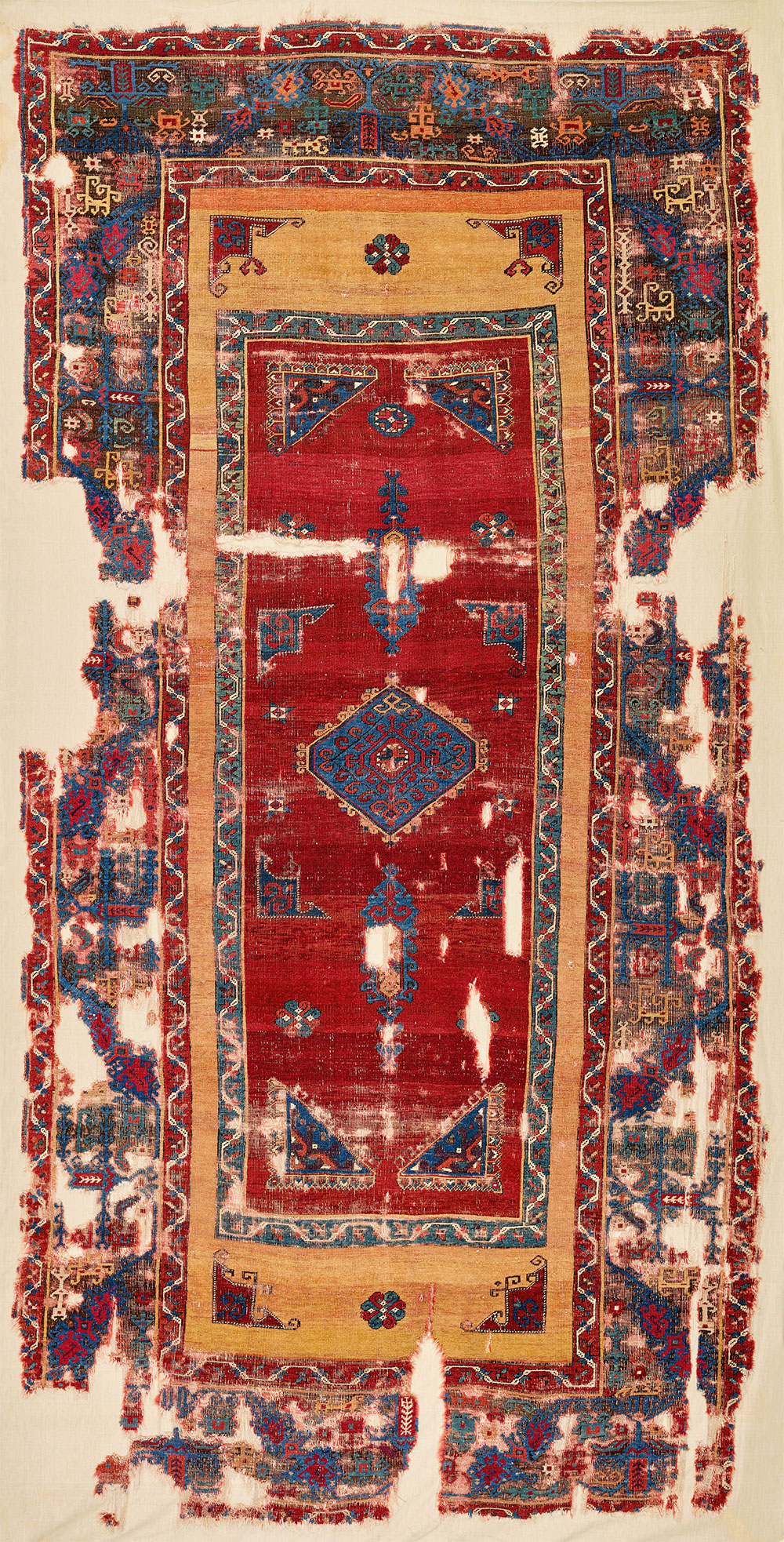
1 ‘Field within field’ design carpet with a ‘fabulous creatures’ border, west Anatolia, ca. 1475–1525. Wool pile on a wool foundatio1n, 1.71 x 3.43 m (5′ 7″ x 11′ 3″). Kirchheim Family Collection, Hannover. Published Orient Stars, Stuttgart, 1993, pl.197. The author has personally examined all but one of the carpets illustrated in this article
When it comes to rug-making, this diversity and mobility means that the same field and border patterns must have been adopted by different tribes in many villages across Anatolia, from the Aegean to Ararat. Thus, design observations cannot be used to form ‘groups’ of rugs attributed to a particular village. Had it been possible to determine that a number of examples were made in (approximately) the same location, it might have been feasible to suggest a chronological sequence based on the evolution of the patterns. But even this would be quite subjective, since a more finely articulated drawing might simply be the product of a better weaver. At all periods there have been good and not-so-good weavers.

3 The Lecco Four-Lobed Star Ushak carpet fragment, west Anatolia, ca. 1475–1525. Wool pile on a wool foundation, 2.70 x 3.95 m (8′ 10″ x 13′ 0″). Private collection, Italy
In attempting to fix the origins and dates of 13th-to 18th-century Anatolian ‘village’ rugs, people often group rugs that have shared ornaments. These may not be indicative of a shared location of origin, as patterns travelled over great distances. It has been suggested that while field designs might be copied from region to region, border designs were far more likely to be common to specific places. We have shown this not to be the case either. Perhaps, on deeper investigation, it might be shown that minor guard stripe patterns might be indicative of origin: they may have been knotted in a somewhat more instinctive and subconscious manner. But this has yet to be proven one way or another.
However, similar minor border patterns were certainly copied over quite wide areas, as we will demonstrate. Were there a large body of material to study, it might be possible to determine local style; but, alas, we rarely have a great number of examples of any one ‘type’, so even this is difficult.
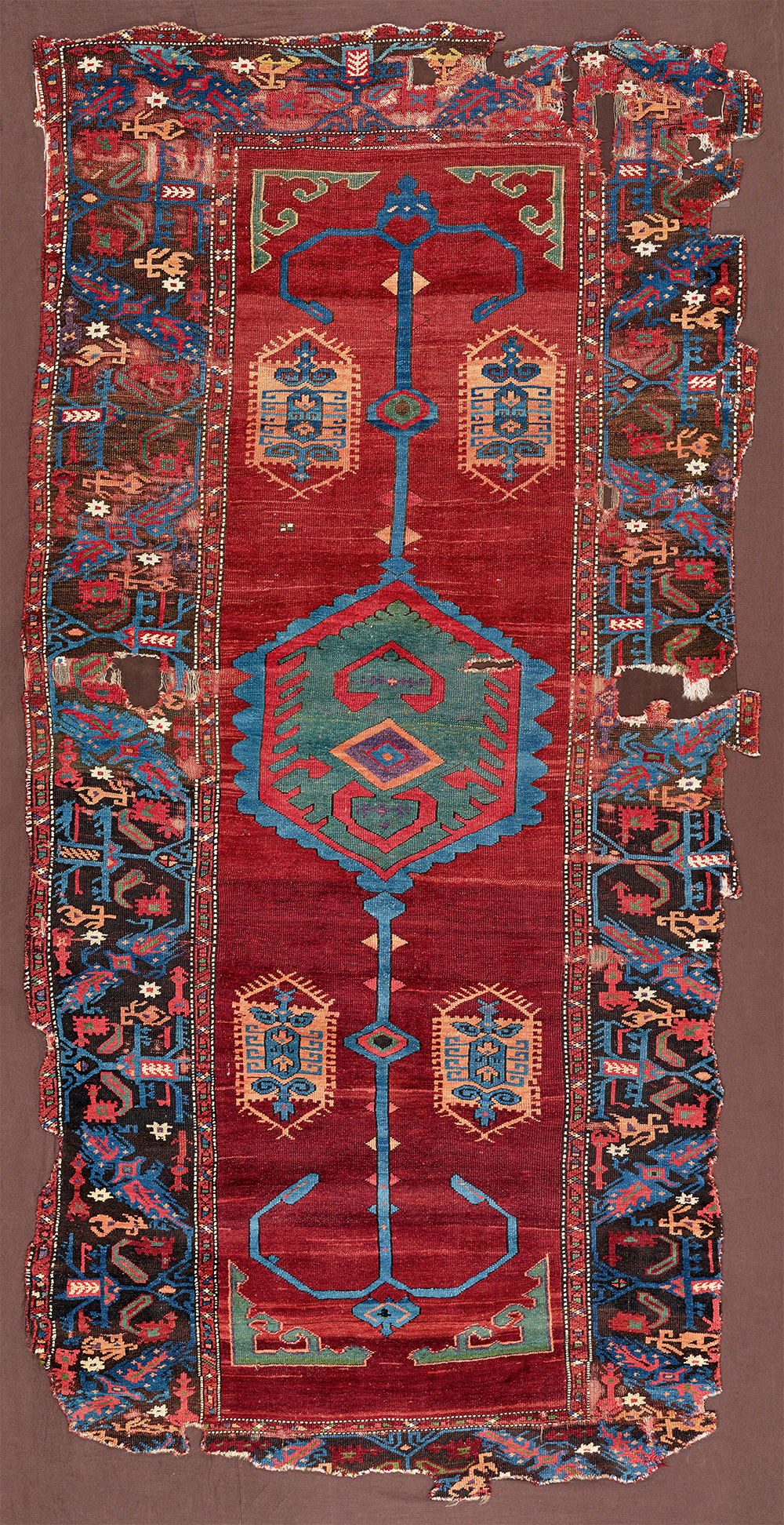
4 Medallion and ‘anchors’ carpet (and border detail), west Anatolia, ca. 1475–1525. Wool pile on a wool foundation, 1.64 x 3.33 m (5′ 5″ x 10′ 11″). Kirchheim Family Collection, Hannover. Published Orient Stars, Stuttgart, 1993, pl.198
There is nothing to compare with direct side-by-side comparison in determining whether two rugs are likely to have originated in the same region. The determining factors are similar wool, similar hues and similar handle—all very subjective observations. Structural analysis goes only so far: different people see different things, they record colours through different eyes, and occasionally the analyses are superficial. But the eccentricities of weave might tell us more about shared features.
Determining the dates of carpets remains more elusive. One might use a number of observations to try to construct chronological sequences of patterns through fragmentation or apparent misunderstanding of what might be considered the original concept. However, such progressions rarely take into account the human factor. Some weavers understood and cared for the so-called correct drawing; others simply copied, perhaps haphazardly, a pattern. This is true of all periods, and it tends to distort any proposed chronological sequences.
Throughout Orient Stars 2 we will suggest possible dates for each rug. These are opinions based on many years of experience. There are remarkably few dated rugs to offer fixed points. Finding similar patterns depicted in western paintings is of no real help, as the rugs illustrated were probably old at the time when they were painted, and patterns continued to be used, often unaltered, for centuries.
Before the late 19th century it was mostly old carpets that were exported. They might have been just a generation old, or older still. It is highly likely therefore that the rugs depicted in western paintings had some age before they were portrayed. We do not know whether the first depiction of an ornament in a western painting represents its beginning, or whether that ornament may have been knotted for decades if not centuries before.
Artists occasionally owned rugs themselves, and these may have acted as studio props; in other cases the rug may have belonged to the sitter. The portrayal of these artefacts may not be accurate. We have evidence of artists combining ornaments from several different carpets, perhaps from various jottings in their sketchbooks. Often artists might have copied a rug depicted in a painting and brought that into their own work, without having seen the rug. Therefore the depiction may not be accurate, as can be seen in the many Florentine Annunciation images with animal rugs.
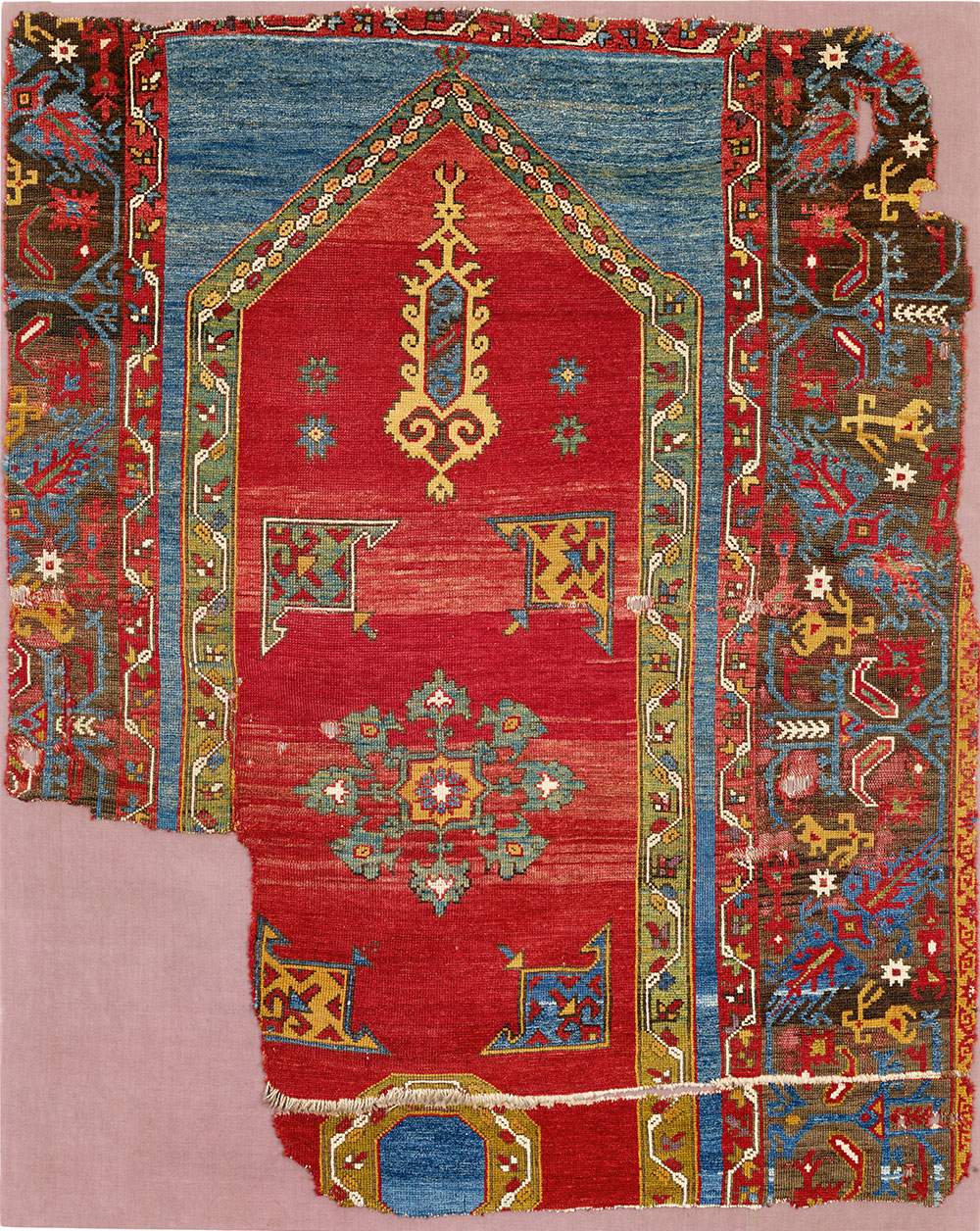
‘Bellini’ keyhole niche rug fragment, west Anatolia, ca. 1525–75. Wool pile on a wool foundation, 1.32 x 1.62 m (4′ 4″ x 5′ 4″). Kirchheim Family Collection, Hannover. Published Orient Stars, Stuttgart, 1993, pl.189
A famous rug with repeating rows of ‘bird’-like creatures in Konya (The Mevlevi Lodge Rows of Bird-Animals Rug) has long been attributed to the 15th century, probably erroneously. This dating has been based on a rug with a similar field pattern depicted in an altarpiece painted circa 1455–60 by the Catalan artist Jaume Huguet (1412–1492). Therefore it is dangerous to use patterns depicted by artists as the sole means of attributing Anatolian rugs.
Three particular rugs in the Orient Stars collection share a similar border pattern, although each has individual features. I have identified here seven other examples that have versions of what I have called the ‘fabulous creatures’ border (2). There are probably others I have overlooked. The three examples in the Orient Stars collection may well have originated in western Anatolia, but there is nothing to suggest that they might be from the same tribe or village. What is fascinating is that, of the examples with this border that we have identified here, no two have similar field design, or indeed similar minor borders.
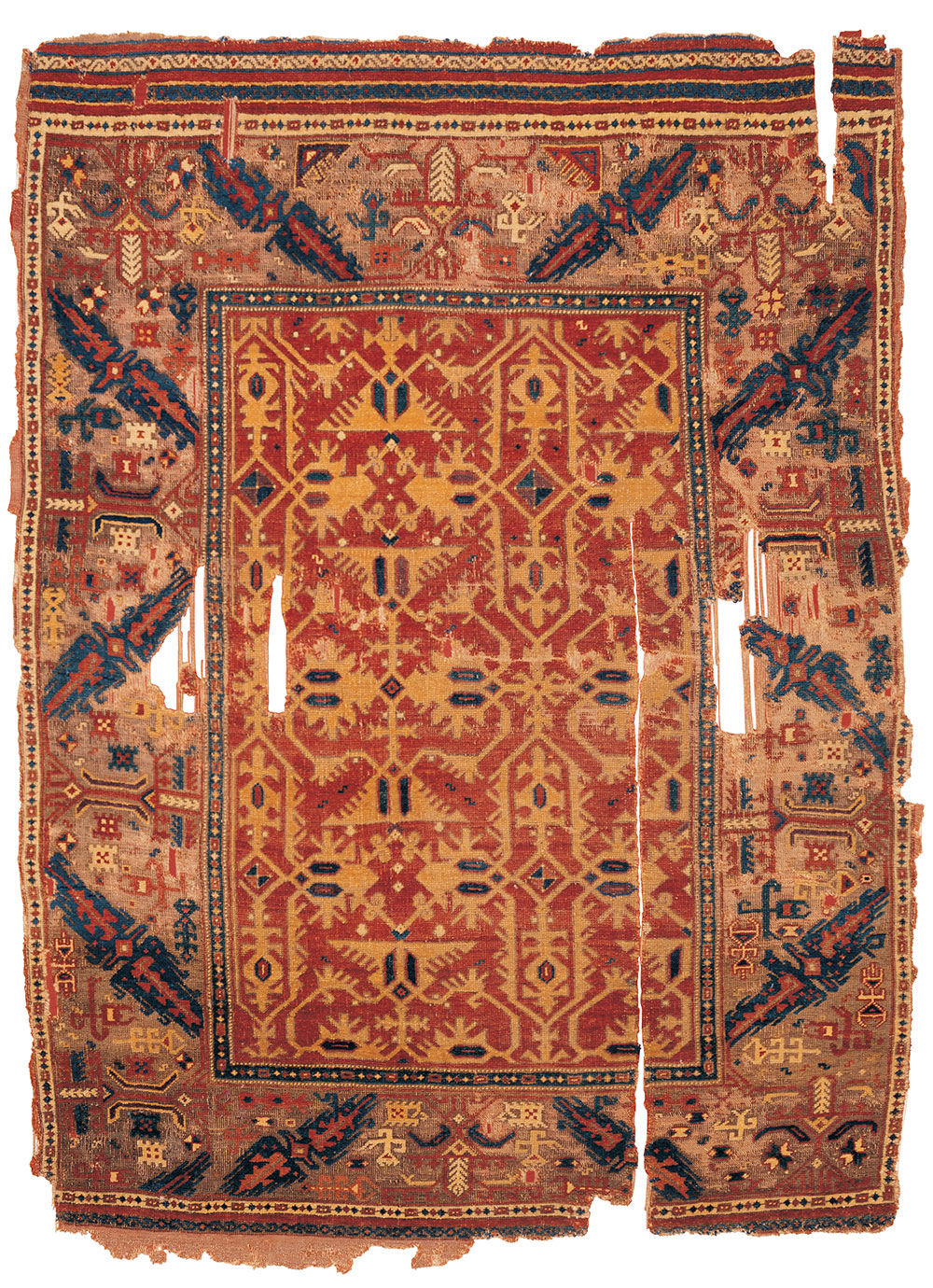
The Alaeddin Keykubad Lotto rug, Ladik region, central Anatolia, ca. 1550–1600. Wool pile on a wool foundation, 1.45 x 1.95 m (4′ 9″ x 6′ 5″). Museum of Turkish and Islamic Arts, Istanbul, no. 16
The pattern is composed of an animal-tree composition, a central tree, which historically has the ‘Great Bird’ on top. It is flanked by confronting creatures: sometimes just one, but often more. Each creature has next to it a small, eight-pointed star and possibly the remnants of another creature above. At the base of the tree is a diamond, and below that a platform. Extending from the diamond is blue line on which is another creature, possible a bird, perhaps two of them, as the pattern is mirrored in the centre.
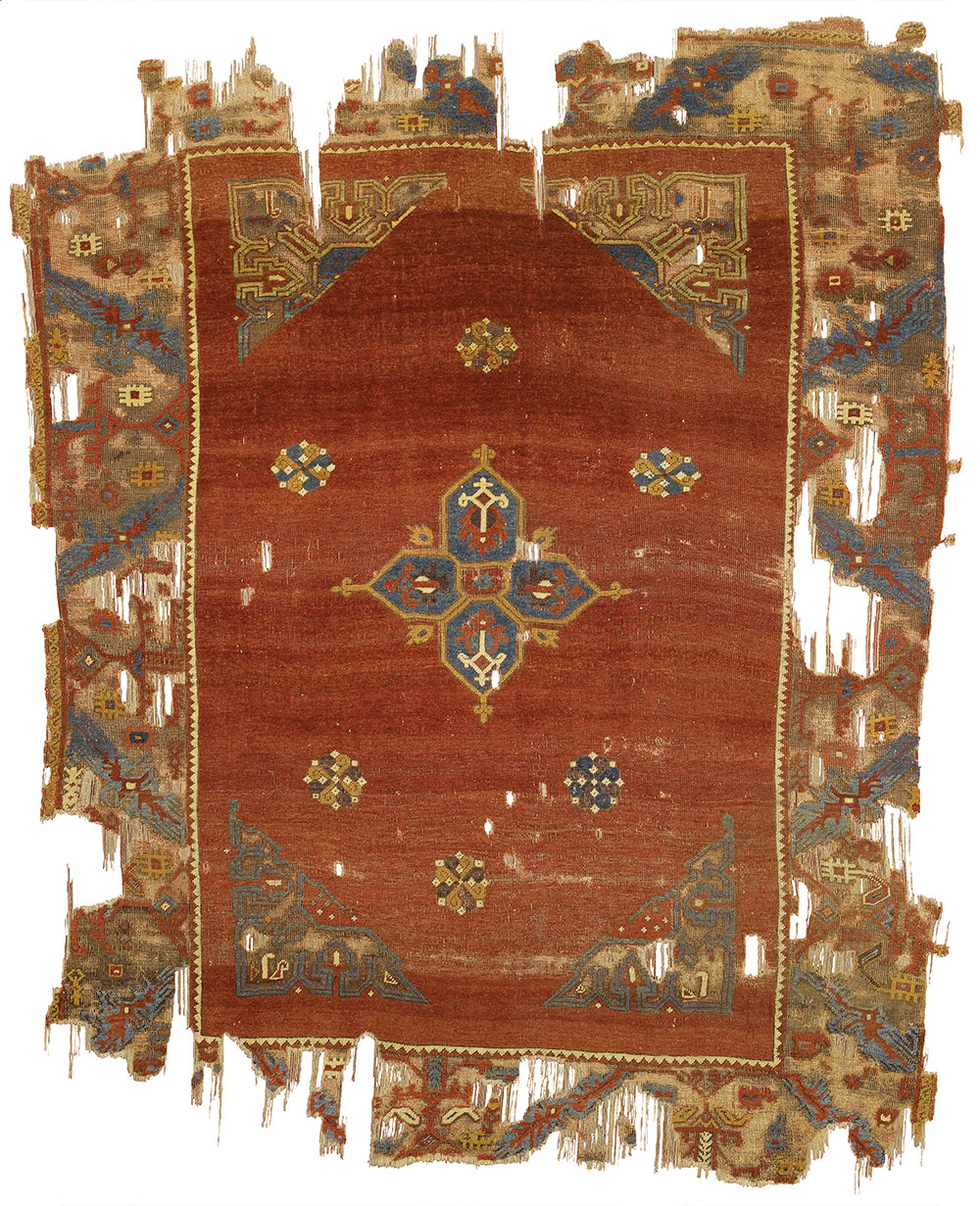
The Alaeddin Keykubad medallion rug, Ladik region, central Anatolia, 1550–1600. Wool pile on a wool foundation, 1.70 x 2.14 m (5′ 7″ x 7′ 0″). Museum of Turkish and Islamic Arts, Istanbul, no. 410
The earliest examples that are probably from western Anatolia may be one of the Orient Stars carpets with ‘Field in field’ design (1) and the Lecco Four-Lobed Star carpet (3). The latter is typical of a small group of carpets from the Ushak region, of which the large-format carpets have three dif erent ornaments in the field, which can be considered to be among the oldest surviving carpets from that region. Some of the surviving examples of this Ushak Star Variant group could represent the earliest surviving Ushak carpets, and may well date from 1450–1525. What is fascinating is that none of the surviving examples shares a border pattern with another. This might suggest that the earliest surviving examples from the Ushak region were not the result of workshops as has so often been written, but were made by weavers in a large number of different villages. The Lecco carpet has two different primary borders, the ‘fabulous creatures’ border on the inside and a more traditional Ushak border on the outside.
























Comments [0] Sign in to comment